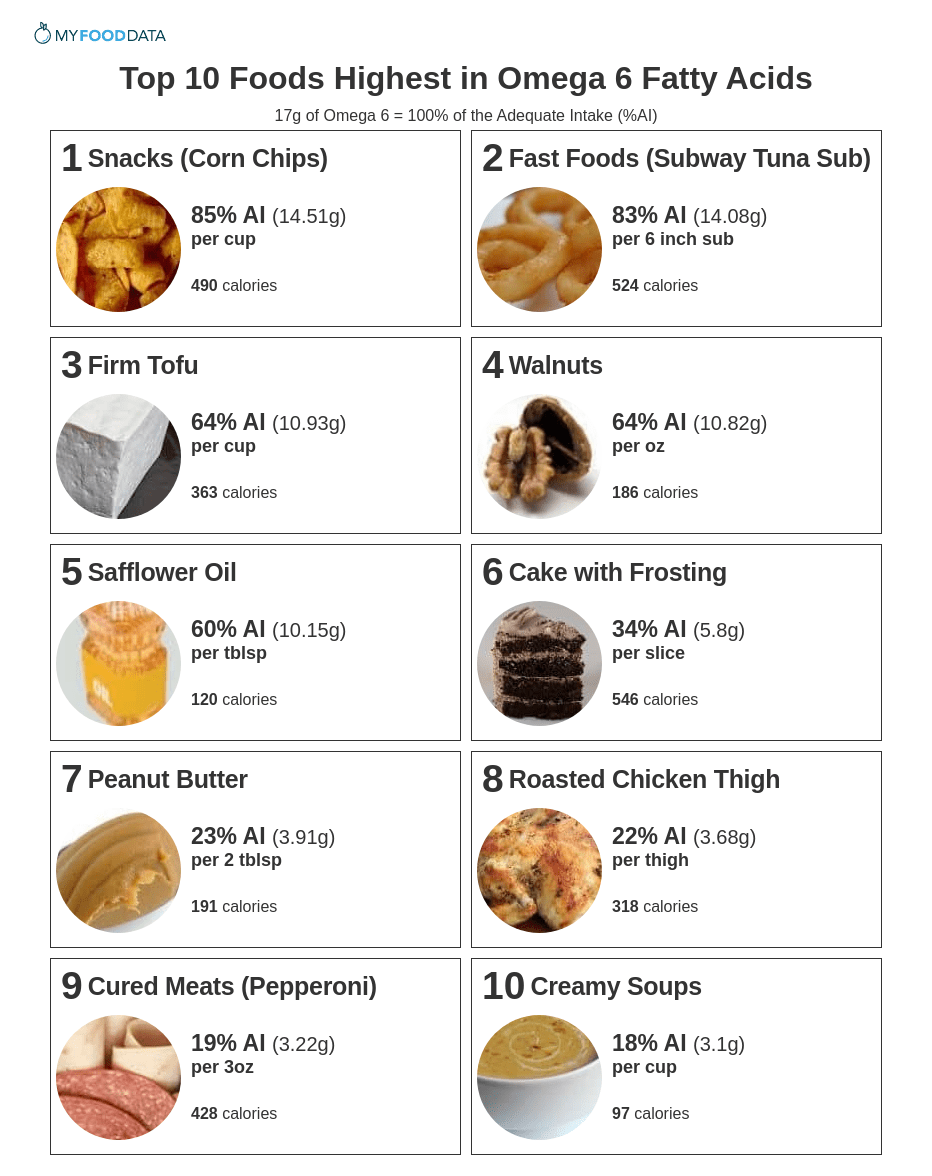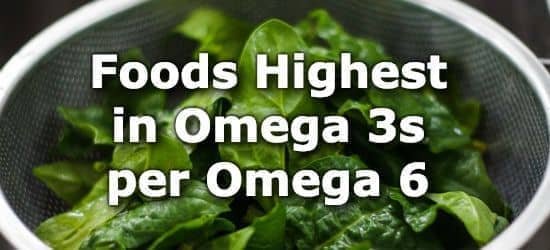Top 10 Foods Highest in Omega 6 Fatty Acids

Omega-6 fatty acids are a type of polyunsaturated fat naturally occurring in nuts, seeds, and vegetable oils. Consumption of omega-6 fatsis increasing due to the wide use of refined vegetable oils and their addition to processed and fast foods. (1)
The increase in consumption of omega 6 fats changes the omega 6 to omega 3 fat ratio. A higher omega 6 to omega 3 ratio is linked to health problems, including an increased risk of cardiovascular disease, cancer, and inflammation. (2)
Increasing omega 3 fats and limiting omega-6 consumption (especially from unhealthy sources) is advisable. See the list of foods with a good omega 3 to omega 6 ratio.
Unhealthy foods high in omega-6 fats include processed snacks, fast foods, cakes, fatty meats, and cured meats. Healthier sources of omega-6 fats include tofu, walnuts, and peanut butter. The adequate intake (AI) for omega-6 foods is 17g per day for men and 12g for women. (3)
Below are the top 10 foods highest in omega 6 fats.
-
1g Omega 3 per 28g Omega 6
 1. Snacks (Corn Chips)
1. Snacks (Corn Chips)
Omega 6
per CupOmega 6
per 100gOmega 6
per 200 Calories14.51g
(85% AI)16.49g
(97% AI)5.92g
(35% AI)More Snacks High in Omega 6 Fats
- 31% AI per oz of potato chips (crisps)
- 30% AI per oz of corn tortilla chips
- 20% AI per oz of peanut granola bars
See all snacks high in omega 6 fats.
-
1g Omega 3 per 7g Omega 6
 2. Fast Foods (Subway Tuna Sub)
2. Fast Foods (Subway Tuna Sub)
Omega 6
per 6 Inch SubOmega 6
per 100gOmega 6
per 200 Calories14.08g
(83% AI)5.94g
(35% AI)5.38g
(32% AI)More Fast Foods High in Omega 6 Fats
- 80% AI in 18 onion rings
- 77% AI per Burger King chicken sandwich
- 74% AI per KFC fried chicken breast
- 47% AI in McDonald's big breakfast
See all fast foods high in omega 6 fats.
-
1g Omega 3 per 7g Omega 6
 3. Firm Tofu
3. Firm Tofu
Omega 6
per CupOmega 6
per 100gOmega 6
per 200 Calories10.93g
(64% AI)4.34g
(26% AI)6.03g
(35% AI)More Soy Foods High in Omega 6 Fats
- 45% AI per cup of boiled soybeans
- 40% AI per cup of tempeh
- 28% AI per 1/2 cup of natto
Tofu is also high in omega 3 fats and is a healthy source of vegan protein and other nutrients.
-
1g Omega 3 per 4g Omega 6
 4. Walnuts
4. Walnuts
Omega 6
per OzOmega 6
per 100gOmega 6
per 200 Calories10.82g
(64% AI)38.09g
(224% AI)11.65g
(69% AI)More Nuts and Seeds High in Omega 6 Fats
- 55% AI per oz of sunflower seeds
- 34% AI per oz of pecans
- 24% per oz of pistachios
Walnuts are also high in omega 3 fats and are a heart-healthy source of many other nutrients.
See all nuts and seeds high in omega 6 fats. -
This food has no Omega 3 fats.
 5. Safflower Oil
5. Safflower Oil
Omega 6
per TblspOmega 6
per 100gOmega 6
per 200 Calories10.15g
(60% AI)74.62g
(439% AI)16.88g
(99% AI)More Oils High in Omega 6 Fats
- 56% AI per tblsp grapeseed oil
- 43% AI per tblsp corn oil
- 42% AI per tblsp walnut oil
- 41% AI per tblsp soybean oil
- 33% AI per tblsp sesame oil
See all oils high in omega 6 fats.
-
1g Omega 3 per 9g Omega 6
 6. Cake with Frosting
6. Cake with Frosting
Omega 6
per SliceOmega 6
per 100gOmega 6
per 200 Calories5.8g
(34% AI)4.03g
(24% AI)2.13g
(13% AI)More Baked Foods High in Omega 6 Fats
- 27% AI in a slice of pound cake
- 26% AI in a 4oz cream filled eclair
- 24% AI in a piece of blueberry pie
The amount of omega 6s will depend on the fat used in baking.
See the list of all baked foods high in omega 6 fats.
-
1g Omega 3 per 437g Omega 6
 7. Peanut Butter
7. Peanut Butter
Omega 6
per 2 TblspOmega 6
per 100gOmega 6
per 200 Calories3.91g
(23% AI)12.22g
(72% AI)4.09g
(24% AI)- 13% AI per tbsp of almond butter
Nut butters are a healthy source of vegan protein.
-
1g Omega 3 per 21g Omega 6
 8. Roasted Chicken Thigh
8. Roasted Chicken Thigh
Omega 6
per ThighOmega 6
per 100gOmega 6
per 200 Calories3.68g
(22% AI)2.69g
(16% AI)2.31g
(14% AI)More Poultry High in Omega 6
- 17% AI per chicken wing
- 17% AI in a chicken hotdog
See all meats high in omega 6 fats.
-
1g Omega 3 per 23g Omega 6
 9. Cured Meats (Pepperoni)
9. Cured Meats (Pepperoni)
Omega 6
per 3ozOmega 6
per 100gOmega 6
per 200 Calories3.22g
(19% AI)3.78g
(22% AI)1.5g
(9% AI)More Pork High in Omega 6
- 22% AI in a rack of pork ribs
- 16% AI per 3 oz of salami
- 13% AI per cup of cured ham
See all meats high in omega 6 fats.
-
1g Omega 3 per 7g Omega 6
 10. Creamy Soups
10. Creamy Soups
Omega 6
per CupOmega 6
per 100gOmega 6
per 200 Calories3.1g
(18% AI)1.25g
(7% AI)6.42g
(38% AI)More Soups High in Omega 6
- 13% AI per cup of chicken soup
- 7% AI per cup of clam chowder
Printable One Page Sheet

How much Omega 6 fats do you need every day?
Below are the daily adequate intakes (%AI) established for omega 6 foods. Adequate intakes are used when there is not enough data to formulate a recommended dietary allowance (RDA). The adequate intake of omega 6 fats ranges between 4g - 17g per day for most people.
| Life Stage | RDA |
|---|---|
| Infants | |
| 0-6 months old | 4.4g |
| 7-12 months old | 4.6g |
| Children | |
| 1-3 years old | 7g |
| 4-8 years old | 10g |
| Males | |
| 9-13 years old | 12g |
| 14-18 years old | 16g |
| 19-50 years old | 17g |
| 51+ years old | 14g |
| Females | |
| 9-13 years old | 10g |
| 14-18 years old | 11g |
| 19-50 years old | 12g |
| 51+ years old | 11g |
| Pregnancy | |
| 14-50 years old | 13g |
| Lactation | |
| 14-50 years old | 13g |
From the Nutrient Ranking Tool
Use the ranking tool links below to select foods and create your own food list to share or print.
- Foods High in Omega 6s
- Foods Low in Omega 6s
- Vegetables High in Omega 6s
- Fruits High in Omega 6s
- Vegetarian Foods High in Omega 6s
- Nuts High in Omega 6s
- Grains High in Omega 6s
- Beans High in Omega 6s
- Dairy High in Omega 6s
- Breakfast Cereals High in Omega 6s
- Fast Foods High in Omega 6s
View more nutrients with the nutrient ranking tool, or see ratios with the nutrient ratio tool.
Related
Data Sources and References
- Harris WS, Klurfeld DM. Changes in consumption of omega-3 and omega-6 fatty acids in the United States during the 20th century Am J Clin Nutr. 2011 May;93(5):907-8. doi: 10.3945/ajcn.111.014365. Epub 2011 Mar 23. 21430117
- Simopoulos AP. The importance of the ratio of omega-6/omega-3 essential fatty acids Exp Biol Med (Maywood). 2008 Jun;233(6):674-88. doi: 10.3181/0711-MR-311. Epub 2008 Apr 11. 18408140
- National Academies Press. Dietary Reference Intakes for Energy, Carbohydrate, Fiber, Fat, Fatty Acids, Cholesterol, Protein, and Amino Acids
Try the recipe nutrition calculator, or daily meal planner.
Create a free account to log and track foods.

 Next ➞
Next ➞